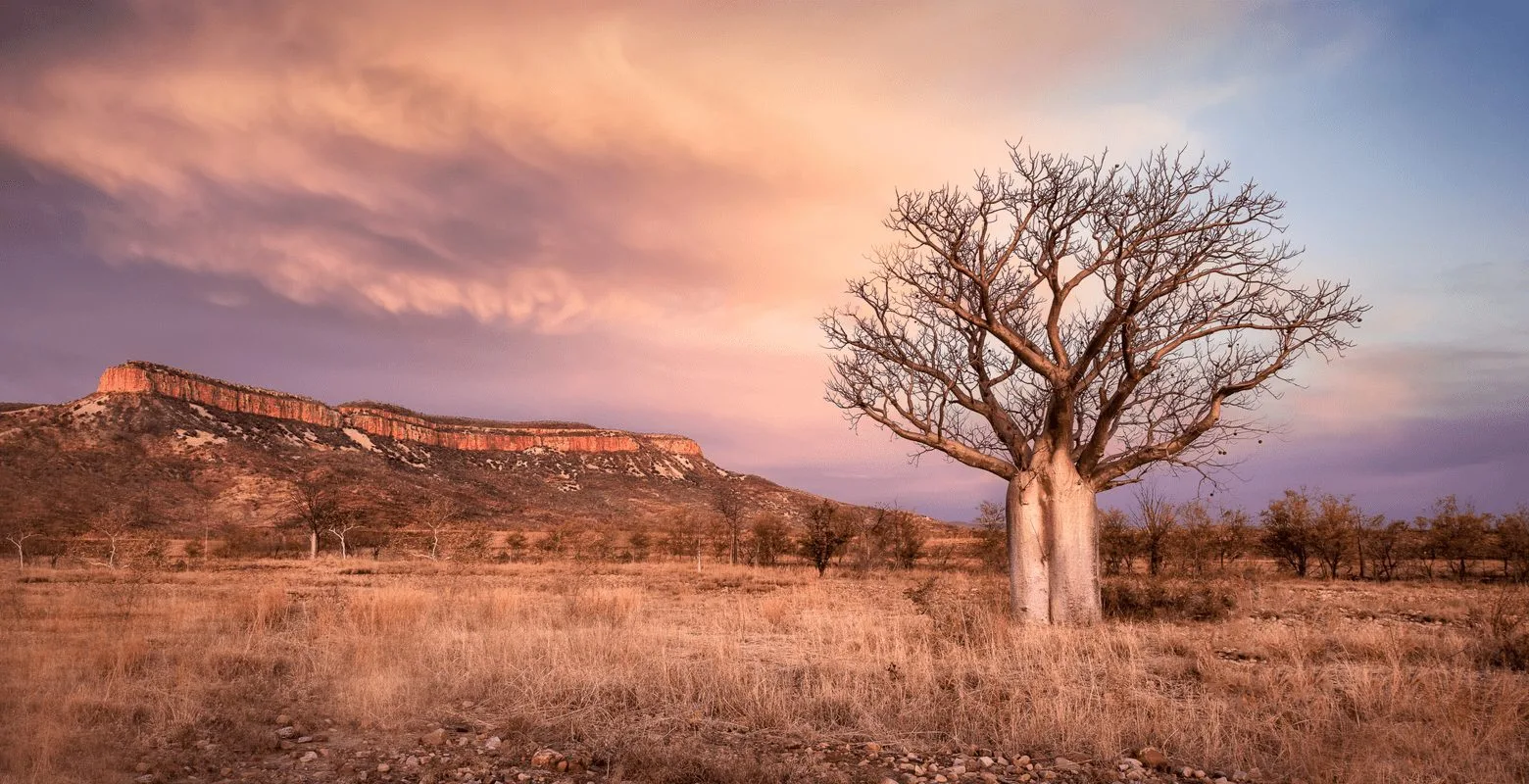Nicknamed the “Wonderland of Baobabs,” Andranomena Reserve is a breathtaking expanse rich in endemic wildlife and plants that you won’t find anywhere else.
What Is Andranomena Special Reserve?
The Andranomena Special Reserve is a protected area located in Madagascar’s Menabe region, just past the rural village of Bemanonga. Given its proximity to the city of Morondava, it is one of the most accessible reserves in the island country.
The reserve’s territory stretches for a total of 6,400 hectares and is primarily composed of alternating landscapes of deciduous forest and scrubland, which stay generally dry throughout the year. Experts relate that more than 60% of the fauna and 75% of the flora living in the area are not just rare, but also purely endemic.
Unlike other protected areas in Madagascar that usually have high levels of annual rainfall, the Andranomena Special Reserve only receives an average of 35 inches of rain per year. This simply means you can fully explore its expanse even if you visit it during the wet season.
The reserve is nicknamed the “Wonderland of Baobabs” because of the different varieties of baobab trees that live in the area. The types of baobab that call this place home include the Za Baobab (Adansonia za), the Grandidier’s baobab (Adansonia grandidieri) and the Fony Baobab (Adansonia rubrostipa).
Interestingly, of the eight known baobab species, six of them are endemic only to Madagascar and the Andranomena Special Reserve is known as one of the few places where different types of these pot-bellied trees live together in the same area.
Apart from its abundance in baobabs, the reserve is also classified as a sanctuary for an array of lemurs and other rare animals, particularly the Madame Berthe’s mouse lemur, the Flat-tailed tortoise, the Malagasy giant jumping rat, the Narrow-striped mongoose, and the cat-like Fossa.
While it doesn’t have as many water sources compared to its counterparts, the Andranomena Reserve has several small seasonal lakes that pop up during the wet season where more than 50 species of birds — most of them quite rare — can be seen hunting for food or just hanging out.
These lakes also have a profusion of aquatic plants that can only be found in and around Madagascar.
Must-See Sights
The Avenue of the Baobabs
The most popular feature of the Andranomena Special Reserve is its abundance of several types of baobabs. There is a particular area in the reserve that is so full of these odd-looking trees that it is referred to as the “Avenue of the Baobabs.”
Besides flaunting large numbers of Za Baobabs, Grandidier’s baobabs as well as Fony Baobabs, the Alley of the Baobabs is also the place where you can find what the locals call the “Baobab Amoureux” or the “baobab lovers.”
While it looks like a giant baobab tree from a distance, the Baobab Amoureux is actually made up of two Za Baobabs that have twisted together as if in a tight embrace.
Local legend has it that a boy and a girl from two different villages met and fell in love. When they decided to marry, their parents forbade them to do so since they belonged to warring tribes.
So they met one evening in the forest and asked God for help. The next day, the other villagers discovered the seemingly embracing baobab trees in the exact spot where the lovers had their tryst.
The Groves of Madagascar Ebony
The Madagascar Ebony is a rare type of tree that is renowned for the blackish color of its heartwood. Locally called as hazomainty, its lumber is primarily used to make musical instruments, furniture and traditional carvings.
The Andranomena Special Reserve has several of these trees living in its expanse and they can be mostly seen in the circuit or trail that leads up to the Avenue of the Baobabs. You can easily spot them with their low-hanging flowers that resemble thick arrows.
The area where these Madagascar Ebony trees grow is also bountiful with Euphorbia antso, a type of succulent that is used to treat scabies, and Hazomalania voyronii, whose wood is the lumber of choice by the locals to make traditional dug-out canoes.
You can also possibly catch a glimpse of the extremely rare Flat-backed spider tortoise (Pyxis planicauda) in this sector of the reserve.
The Assortment of Lemurs
The Andranomena Special Reserve is home to more than ten (10) types of lemurs and it is also one of the few places where the Madame Berthe’s mouse lemur (Microcebus berthae) can be seen. Having a body length of only 3.6 inches, it is classified as the world’s smallest primate.
Apart from the Madame Berthe’s mouse lemur, the reserve also houses active populations of the Pale fork-marked lemur, the Fat-tailed dwarf lemur, the Coquerel’s Giant Mouse Lemur, the Western Fork-crowned Lemur, the Common brown lemur, the Red-tailed sportive lemur and the Verreaux’s sifaka, just to name a few.
The Fossa
The Fossa is one of the most mysterious animals not just in Madagascar but also in the whole world. While it basically looks like a giant cat, it is actually closely related to the mongoose.
Known as the largest carnivore in the country, the Fossa is an agile climber and has a varied diet of insects, frogs, birds, lizards, fish and other small mammals.
The Andranomena Special Reserve is also one of the places in Madagascar where this creature lives and you might just encounter it when exploring the reserve’s large stretches of dense deciduous forests.
Although locals swear by its ferocity, the Fossa actually avoids people and will most likely scramble up a tree rather than confront tourists head on.
Activities You Can Do
With its varying terrains and extraordinary endemic biodiversity, the Andranomena Special Reserve is an ideal destination for nature lovers who are looking to take adventure to a whole new level.
Hiking is the top activity that you can engage in when you visit the reserve. There are two (2) circuits or trails in the area, namely the Antsarongaza Circuit and the Circuit of the Four Lakes, that you can go for depending on the sights you’d like to check out and the type of terrain you are at most comfortable travelling on.
Roughing it out on the Antsarongaza Circuit
The Antsarongaza Circuit will mostly take you through the reserve’s scrubland and deciduous forests where you will get to see a number of reptiles and lemurs. On sunny days, you may also get to catch sight of the rather elusive Flat-tailed tortoise chilling out near the bushes and the roots of the trees.
While the trail starts out flat, you will negotiate some loose rocks, a few inclines here and there as well as tracts of sandy soil as you go along, so it is recommended that you grab a pair of hiking shoes that will give you a maximum amount of traction to make your trek more manageable.
The average time to complete the Antsarongaza Circuit is two (2) hours.
Go bird-watching in the Circuit of the Four Lakes
The Circuit of the Four Lakes is named as such because its path leads you through the Andranomena Special Reserve’s seasonal lakes where a lot of rare birds can be seen wading or looking for food. The area in and around these lakes are also blanketed by endemic water plants that serve as spawning grounds for several amphibians.
These lakes tend to dry up — sometimes even completely — during the dry season. The ideal time to take the Circuit of the Four Lakes is between the months of December and March when the wet season is at its peak.
The average time to complete this circuit is about two (2) and a half hours and can even extend up to three (3) hours if the path is considerably muddy, especially if it just rained.
Make sure you put on a reliable pair of hiking boots, preferably a high-cut one, to negotiate the trail. Apart from ensuring that your feet won’t get wet, you’ll also keep bugs and leeches at bay. Wearing gaiters is also highly recommended.
Some Quick Reminders
The Andranomena Special Reserve can be visited throughout the year.
Unlike other protected areas and national parks in Madagascar, the Andranomena Special Reserve is accessible the year round even during the wet season. This is attributed to the low annual rainfall the reserve receives as well as the profusion of baobab trees in the territory that prevent flooding.
Only available for day trips.
While other reserves have basic facilities and a campground that can accommodate tourists for overnight stay, the Andranomena Special Reserve has none and is only available for day trips.
Moreover, despite the fact that you cannot spend the night in the area, the reserve features two of the most straightforward circuits, namely the Antsarongaza Circuit and the Circuit of the Four Lakes, if you’re looking to get up close and personal with rare lemurs and birds as well as towering baobabs.
Getting There
The Andranomena Special Reserve is approximately 30 kilometers away from Morondava’s northern tip and can be reached by car if you take the highway leading to the town of Belo-sur-Tsiribihina.
Going for a 4×4 vehicle is highly recommended if you want to steer clear from unexpectedly bogging down as you travel the mostly dirt road. Apart from encountering large potholes, there are also stretches of the road that are filled with loose rocks that can be a bit tough to handle if you’re using a regular vehicle.
While the route to Belo-sur-Tsiribihina and eventually the Andranomena Special Reserve’s premises is accessible throughout the year, the road can be really muddy and tricky to pass through from December to March.
Where to Stay
Unlike most of its counterparts, the Andranomena Special Reserve does not feature any infrastructure or campgrounds for tourists. The nearest hotels that you can stay in are located in the city of Morondava.
Hotel Trecicogne Morondava
Known for its overlooking view of the nearby lagoon, Hotel Trecicogne Morondava is a favorite among tourists who’d like to keep their spending minimal without skimping on comfort and convenience.
The place is just a few minutes’ walk away from the nearby beach and its in-house garden is also filled with baobab trees and other native plants that gives the place a laid-back atmosphere.
This hotel offers 20 Sakalava-inspired rooms with modern amenities as well as a kitchen for guests who opt to prepare their meals themselves. Besides the traditional Malagasy menu, its restaurant can also cook up various salads and pasta dishes.
You can reach out to Hotel Trecicogne Morondava at:
- Tel: +261 20 95 942 13 or +261 34 51 636 66 or +261 32 04 687 60
- Email: trecicogne@moov.mg
- Address: Bp 243 – Nosy Kely – Morondava, Morondava 619 Madagascar
- Website: hoteltrecicogne.mg/en/home/
Hotel Maeva
Hotel Maeva is a reasonably-priced hotel located just 200 meters away from the shore of the Morondava beach. It features a fusion of post-Colonial and traditional Malagasy architecture and decor and is accented with native plants.
Its proximity to the beach allows guests to see some of the most stunning sunsets in the comfort of their rooms. Visitors can also get up close and personal with a few gigantic baobab trees near the hotel.
You can reach out to Hotel Maeva at:
- Tel: +261 32 70 946 39
- Address: Morondava 401, Madagascar



